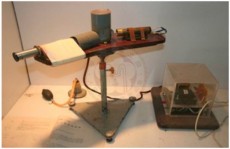TELDAP Collections
| Millikan’s Oil-Drop Experiment |
|
Millikan’s Oil-Drop Experiment can accurately determine the charge of a single electron. The major body of the experiment is a small flat-plate electric field. We initially have many little oil droplets randomly move in the electric field. Shortly ionize the air in the electric field to have the droplets carry various charges. Observing the speed of motion of the oil droplets, we can calculate the charges in each droplet and deduce the quantity of a single charge. This research rewarded Robert Millikan the Nobel Prize in Physics in 1923.
Microscope Video Millikan’s Oil-Drop Experiment
|













